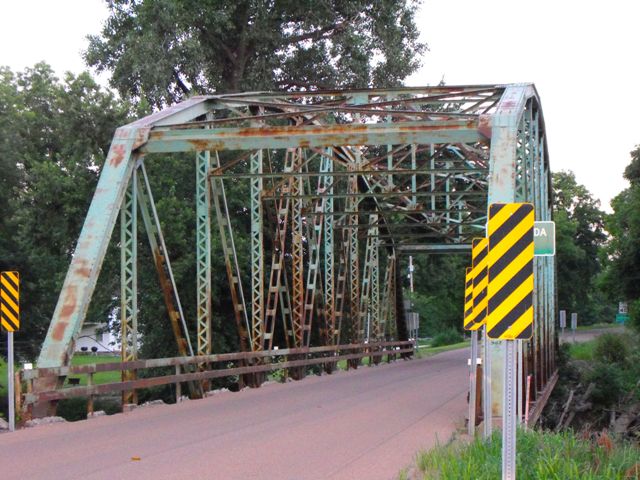We Recommend:
Bach Steel - Experts at historic truss bridge restoration.
BridgeHunter.com Phase 1 is released to the public! - Visit Now
MO-B Wyaconda River Bridge
La Grange Bridge

Primary Photographer(s): Nathan Holth and Rick McOmber
Bridge Documented: July 3, 2009
Near La Grange: Lewis County, Missouri: United States
Not Available or Not Applicable
185.0 Feet (56.4 Meters)
185.0 Feet (56.4 Meters)
22 Feet (6.71 Meters)
1 Main Span(s)
5610

View Information About HSR Ratings
Bridge Documentation
View Archived National Bridge Inventory Report - Has Additional Details and Evaluation
This historic bridge was demolished and replaced in 2013!
HistoricBridges.org found itself at this bridge unexpectedly and ended up documenting this bridge in the very last moments of daylight. Detail photos were acquired using a highly effective flash, and overview photos were taken by steadying the camera on whatever was available. Despite this, the photos came out not too bad all things considered. However, the darkness did not allow for more than a couple photos of the parallel historic railroad truss bridge. The railroad truss bridge is a six panel pin-connected Pratt through truss. The couple grainy photos acquired of this railroad bridge are available in this bridge's photo gallery.
The MO-B Bridge is a traditional and attractive example of a standard plan truss bridge in Missouri. It is located next a short distance from the aforementioned railroad bridge and a little further away is the Mississippi River, not visible from the bridge.
This bridge is one of Missouri's remaining standard plan
truss bridges. As the first and second decades of the 20th Century passed
by, the movement to have states develop standard plans for bridges for the
purpose of bringing a greater measure of quality control, efficiency, and
consistency to bridgework in the nation took hold. In response to this
movement, states developed standard plans for the bridge types that were
most common and functional during the period. From the mid 1910s through the
1940s, many (but not all) states had developed standard plans for truss
bridges which were used to in situations where large spans were desirable.
While these standard plan truss bridges meant an end to the diversity of
truss bridge appearances and designs seen during the earlier period where
individual bridge companies designed the bridges, these standard plan truss
bridges remained among the most intricate and visually intriguing bridge
types. In addition, variety was still achieved because these standard plans
were revised over the years, and different designs for different span
lengths existed, and differences in skew and span numbers create additional
variety. Moreover, these standard plan truss bridges are interesting because
while they are all similar within each state, they are quite different from
state to state because each state designed its own standard plans for truss
bridges, and the designs they chose might be quite different from other
states. Among the fifty states differences seen among truss bridge standard
plans include truss configuration, portal bracing designs, built-up and
rolled beam designs and placements, railing, and plaques.
Missouri's
standard plans for trusses are usually either a Parker truss (long spans), a
Pratt through truss (medium spans), and a subdivided Warren pony truss
(short spans). Perhaps the most distinctive feature of Missouri's standard
plan through truss bridges is their portal bracing. On most truss bridges,
the portal bracing is the most structurally and visually substantial piece
of bracing on the bridge. While Missouri's portal bracing may be
structurally substantial, visually it is one of the smallest portal bracings
ever seen, consisting of a single rolled or built-up beam, depending on the
bridge. The sway bracing on through truss bridges is also simple, often
being the same design as the portal bracing, if less massive. In contrast,
the diagonals and verticals of the truss web tend to be built-up beams that
are more visually appealing because they contain a combination of v-lacing
and battens to create their built-up beams at these locations. Top chords on
the bridges are generally built-up box beams that include v-lacing on the
bottom. Indeed, v-lacing is the trend on these bridges for built-up beams,
along with battens. Lattice is not usually seen. Plaques on the bridges are
simple and uninformative, with historical information limited to no more
than the construction date. Looking at all the features of Missouri's
standard plan truss bridges, in terms of aesthetic quality, they rate
similarly in aesthetic quality standard plan truss bridges in other states.
![]()
Photo Galleries and Videos: MO-B Wyaconda River Bridge
Bridge Photo-Documentation
Original / Full Size PhotosA collection of overview and detail photos. This gallery offers photos in the highest available resolution and file size in a touch-friendly popup viewer.
Alternatively, Browse Without Using Viewer
![]()
Bridge Photo-Documentation
Mobile Optimized PhotosA collection of overview and detail photos. This gallery features data-friendly, fast-loading photos in a touch-friendly popup viewer.
Alternatively, Browse Without Using Viewer
![]()
Maps and Links: MO-B Wyaconda River Bridge
Coordinates (Latitude, Longitude):
Search For Additional Bridge Listings:
Bridgehunter.com: View listed bridges within 0.5 miles (0.8 kilometers) of this bridge.
Bridgehunter.com: View listed bridges within 10 miles (16 kilometers) of this bridge.
Additional Maps:
Google Streetview (If Available)
GeoHack (Additional Links and Coordinates)
Apple Maps (Via DuckDuckGo Search)
Apple Maps (Apple devices only)
Android: Open Location In Your Map or GPS App
Flickr Gallery (Find Nearby Photos)
Wikimedia Commons (Find Nearby Photos)
Directions Via Sygic For Android
Directions Via Sygic For iOS and Android Dolphin Browser
USGS National Map (United States Only)
Historical USGS Topo Maps (United States Only)
Historic Aerials (United States Only)
CalTopo Maps (United States Only)

